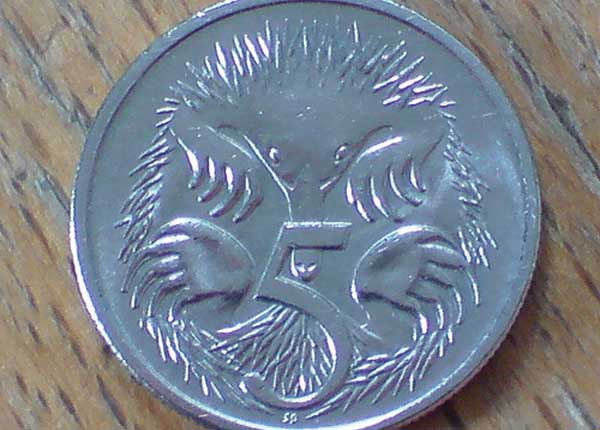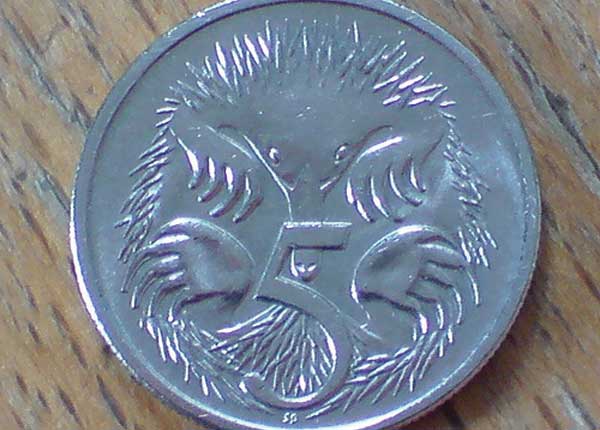Love it loathe it, Australia’s humble little 5 cent coin appears imminently destined for the numismatic scrap heap after the head of the Royal Australian Mint told a Senate estimates hearing that the nation’s smallest piece of legal tender costs more to produce than its actual face value.
The head of the Commonwealth’s Canberra coin factory, Ross MacDiarmid, has told a Senate Estimates hearing that it now costs six cents per piece to produce a five cent coin, a statistic that partially explains why the Abbott government appears keen to sell the facility off.
Mr MacDiarmid told the hearing that although there were around five billion coins “in circulation at any one point in time” the Mint still produced 255 million coins a year – literally small change by international standards.
“It is actually in decline, which is why it is probably an appropriate time for us to be doing a review,” Mr MacDiarmid said.
“Because, quite frankly, if our core business is in decline, this should be the opportunity for us to look and see what the next 10 years looks like.”
While Finance Minister Mathias Cormann has already sent the Mint’s potential sale off to a scoping study to weigh-up the potential revenue upside, the revelation that some coins cost more to produce than they are worth appears certain to prompt a rethink of the coin catalogue.
By any measure, getting rid of coins that now cost more to make than they are worth would be a logical step on the road to eventual privatisation because it would remove dead weight from the balance sheet.
Mr MacDiarmid said the Mint had submitted a proposal “for a review of the coin array for Australia, which includes looking at the 5c piece” but added that the assessment was “on hold at the moment.”
“It would also be subject to reaction from the marketplace—that is, consumers, banks and other stakeholders,” he said.
Senator Cormann was more forthcoming about his views on the value of the five cent coin, saying that “there is obviously some scope for improved efficiencies.”
Payment card schemes like MasterCard and Visa have for years pushed policymakers to embrace the notion of dumping cash and coins in favour of greater uptake of transactions like contactless tap-and-go payments for everything from parking meters to petrol.
However contactless cards typically need to be linked to some sort account to draw on, a hurdle that potentially excludes the so-called ‘unbanked’ and stands in the way of eliminating coinage.
Meanwhile, Australians’ propensity to somehow disappear a whopping 250 million bits of shrapnel a year is costing consumers and taxpayers dearly.
The Estimates hearing was told that it now costs $110 million a year to replenish the supply of coins in circulation, a figure that caused Labor Senator Sam Dastyari to marvel at how so much money made it “down the back of chairs and whatnot.”
Mr MacDiarmid offered that the coins could be “sitting in people’s drawers for long periods of time or in jars.”
Who would potentially stump up money for what is admittedly a declining business – or what value that could be returned to the taxpayer by doing so – remains to be seen.






What will I fill my piggy bank with?
Keep 5 cents
If this is the case, then the 10c and 20c are on their way too.
Both are made from the same metals, the 10c weighs 2x the 5c and the 20c weighs 4x the 5c.
But the cost of 6c per coin isn’t just the value of the metal, it is also the cost of making the coin. So if the metal cost 4c and the process cost 2c then the metal in the 20c piece might cost 16c, but even if the 20c process cost 3.5c it would still be economical to make.
Process costs might include both the cost of running the machinery and the costs of storing and transporting both the raw materials and the finished coin.
I’m making up the figures of course – this is just my supposition of why they would specify the 5c piece being expensive (and at risk!) but not the 10c and 20c piece. I would be interested to see if there is any breakdown anywhere of the specific costs of materials vs process.
I think the mint should keep it but just make them out of copper just like the 1 and 2 cent coins were. Stop the current cuprisnickel ones (silver) .
New Zealand done it with theirs, they were silver now completely copper, we must save them because rounding to the nearest 10 cents will push up prices every where especially ‘bit piece’ prices like screws and bits at wholesale level.
We must do better than just delete them from circulation.
If the government wants their coins back, they should offer an incentive to pay 10% extra of any silver coins deposited in a bank. That way they’re only losing half a cent per 5c coin, and even just 5c from a 50 coin, but it will encourage thousands of people to clear out a stash they have never bothered to do anything with. Half a cent is nothing to the federal government, but to someone who has $100 in coinage stashed away, $105 will seem pretty good.
I’m all for scrapping the fiddly little things. Especially if they’re no longer accepted by most machines.
As for the fears of rounding affecting prices, there’s an easy way to deal with that: ties-to-even or ties-to-odd.
Because 5 is exactly halfway between multiples of 10, there’s no “nearest 10” to round to. There is, however, a “nearest even multiple of 10” and “nearest odd multiple of 10” you can round to instead.
Ties-to-odd would give a slight bias towards 10-cent coins, while ties-to-even would give one towards 20-cent coins and a lesser one towards the dollar coins (owing to 5 rounding to 0 and 95 rounding to 100).
Whether you use ties-to-even or ties-to-odd, you’ll have five values ending in 5 which round up and five which round down.
I’m all for abolishing the 5c piece, I think inflation has killed it. There is actually almost no need for low value coins. In fact, if we abolished all coins and went back to $1 and $2 notes, it would make life much simpler. However, that’s a bit of a pipe dream, what I would really love to see is a new $200 note and I would love to see the 50c piece changed to be round again (instead of dodecagonal).
Actually the way the kiwis redesigned their coins was very good. Modern coin recyclers in Australia don’t recycle 50c pieces (most of the time) and this means that more 20c have to be used etc. Whenever that happens it promotes inefficiency.
I was reading some articles about the American currency and they have these problems too. Firstly, they still have a 1c coin, which is costing them hundreds of millions. Their 10c is smaller than their 5c because of a quirk of history. Because the American mint let their silver coins go on too long, the public doesn’t use ‘half dollars’ enough. They have a $1 coin alongside the $1 note, but no one really likes the $1 coin. They print huge quantities of $100 bills and export them overseas every year, but say that there is no demand for higher denomination notes. The mind boggles.
Personally, I have gone back to cash, I enjoy it…but not the coins. I routinely have 10 of each denomination in my wallet (even 100s) and will often have 200 or 300 bills at Coles and will use the hundreds to pay for them and every now and then will go to the bank and pickup another one to two thousand worth. $10 notes are currently my most used note, so I have literally hundreds of them in my possession at any one time.
In terms of notes, I think the Euro is probably the best designed; the Singapore dollar is also fairly well endowed with a good spread of banknotes. Singapore has retired its 10,000 dollar notes under lobbying pressure from Indonesia, but I think with the demand for US$100 bills so high, it seems like there would be a big demand for $10k or $1k US notes again.
In Australia, I would very much appreciate 200 and 500 notes, abolition of the 5c and the redesign of the 50c to be round again.
Let’s copy America yet again and have a 25 cent coin. Our own Aussie quarter.
That does not make any cents!
i need to fill my piggy bank!